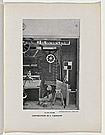Le Pas d'Acier [Steel Step]
Ballet in two scenes
- Producer: Les Ballets Russes de Serge Diaghilev
- Premiere: 7 June 1927, Théâtre Sarah Bernhardt, Paris
- Costume design: Georgy Yakulov
- Costumier: A Youkine
- Scenery design: Georgy Yakulov
- Music: Serge Prokofiev
- Choreography: Léonide Massine
- Libretto: Serge Prokofiev, Georgy Yakulov
- Main characters: The Sailor, the Worker Girl, male and female workers, peasants
The first act is set in a train station during the Russian famine. The train station was a common representation of change, transition and progress in early Soviet art. This first section introduces the hero and heroine, the Sailor and the Worker Girl, as a pair of lovers. The second act is set in a multi-level factory where the lovers are separated. The second half of the ballet revolves around the pair trying to reconnect. Eventually they are set to work together and their love is celebrated by the other workers.
The ballet scenario is a metaphor for the transformation of the Soviet Union into an industrialised nation. It was the only Ballets Russes production to have both a Soviet revolutionary theme and a Constructivist design and was originally titled Ursignol, the combination of ‘URSS’ (French for USSR) and ‘gnol’ from the end of rossignol (nightingale)—a reference to Diaghilev’s 1914 production of Stravinsky’s opera Le Rossignol (The nightingale). Its title has been variously translated as ‘Steel dance’, ‘Step of steel’ and ‘The steel leap’. While the ballet celebrated the ideal of the Bolshevik state and the supposed nobility of an industrialised society in transition from rural poverty to collective wealth, in the rich Western context in which it was received it represented a soulless, exploitative and grim future. The costumes are asymmetrically-cut workers’ clothes in synthetic ponyskin and coarse, plain, rust, grey and blue fabrics, overlaid with aprons in the industrial imitation leather fabric known as in the 1920s as ‘American cloth’. The ballet was not popular with its anti-Bolshevik émigré Russian Paris audience and also suffered against the film Metropolis, by German director Fritz Lang, which had premiered in Berlin five months earlier(although with wider release not until 1928). The film’s depiction of the harshness of an industrial future for society, clothed in a stylistic extension of fashionable Art Deco design, had the advantage of powerful and emotional visual narrative in a period where the cinema was capturing the attention of audiences from all classes of society.








